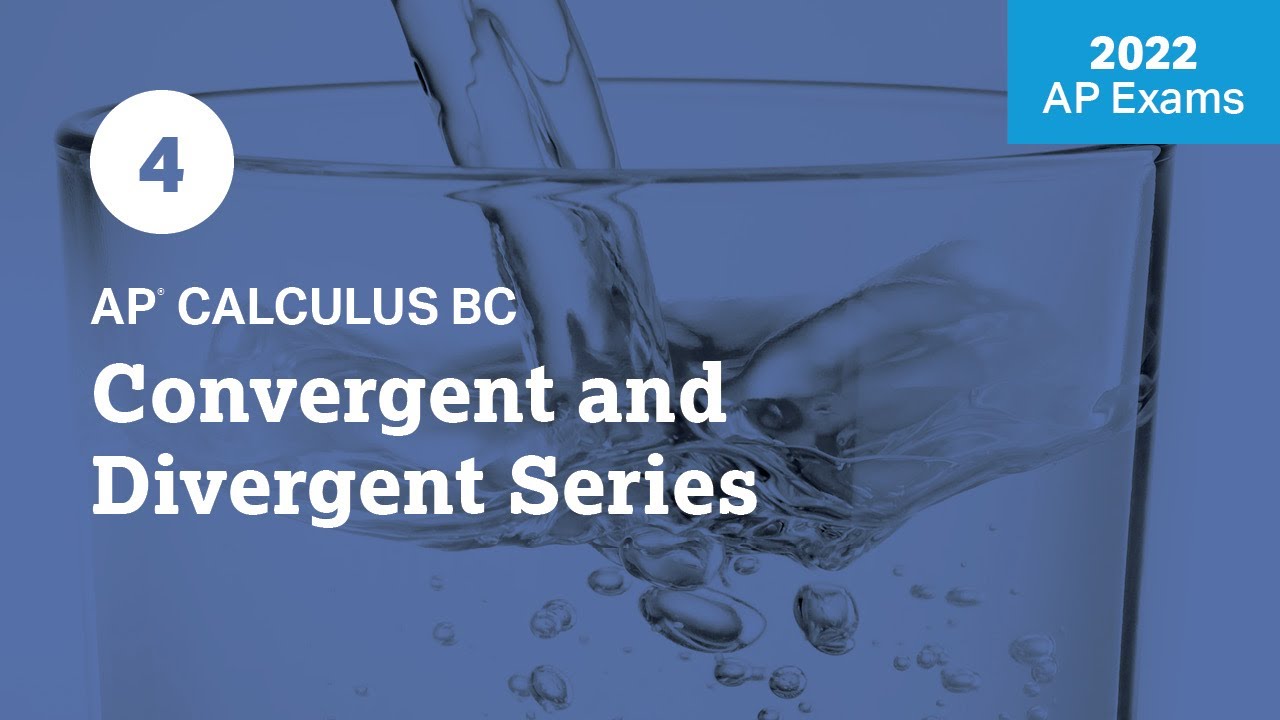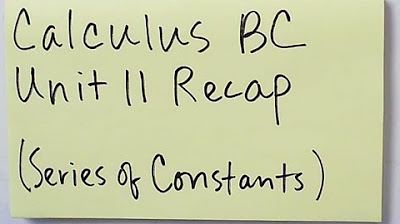2021 Live Review 6 | AP Calculus BC | Everything You Need to Know About Convergence Tests
TLDRIn this engaging video, the presenters tackle the complex topic of series convergence, a common challenge in calculus. They demystify the subject by discussing various convergence tests, including the geometric and alternating series tests, and their applications. The video features detailed examples and problem-solving techniques, emphasizing the importance of checking conditions and understanding the nuances of each test. The presenters also hint at upcoming topics, such as Euler's theorem and the Intermediate Value Theorem, promising a comprehensive review for the AP Calculus exam.
Takeaways
- 📚 Series convergence can be challenging but understanding the tests and conditions is crucial for success in calculus.
- 🧠 The alternating series test (AST) requires two conditions: the non-alternating component approaching zero and the terms decreasing in size.
- 🔢 For absolute convergence, the harmonic series (1/n) is a key example that diverges, helping to identify series that do not converge.
- 📈 When dealing with series that converge to a specific value, geometric series are a fundamental concept to recognize and apply.
- 🤝 Collaboration between teachers and students is essential to demystify complex topics like series convergence.
- 🎯 Always check the conditions of the convergence tests, such as the ratio test for geometric series and the alternating series test for alternating series.
- 🌟 The concept of error bounds, such as the alternating series error bound, provides a way to estimate the accuracy of a series approximation.
- 📊 The ratio test is a powerful tool for determining the radius of convergence, but it requires careful application and checking of endpoints.
- 🛠️ Simplify expressions before applying calculus tests to save time and reduce complexity.
- 🎓 AP exam questions often involve a combination of series tests and conditions, so a thorough understanding of each is necessary for correct answers.
- 📈 The importance of showing work and understanding the nuances of each convergence test is emphasized on the AP exam, as it tests the depth of knowledge.
Q & A
What is the main topic discussed in the transcript?
-The main topic discussed in the transcript is series convergence, specifically focusing on various convergence tests and their application in solving problems related to AP Calculus exams.
What is the significance of series convergence in calculus?
-Series convergence is significant in calculus as it helps in understanding the behavior of infinite series, which is crucial for approximating functions, solving differential equations, and analyzing various mathematical problems.
What are the different types of series convergence tests mentioned in the transcript?
-The transcript mentions several series convergence tests including the Alternating Series Test (AST), the Geometric Series Test, the Harmonic Series Test, and the Ratio Test.
How does the Alternating Series Test (AST) work?
-The Alternating Series Test (AST) works by checking if the series is alternating and if the terms of the series decrease in size as n increases. If the limit of the non-alternating part of the series as n approaches infinity is zero, then the series converges conditionally.
What is a condition that must be met for a series to be absolutely convergent?
-For a series to be absolutely convergent, the sum of the absolute values of its terms must converge, which means the series without the alternating signs must have a finite sum.
How does the Ratio Test determine the convergence of a series?
-The Ratio Test determines the convergence of a series by comparing the ratio of consecutive terms as n approaches infinity. If the limit of this ratio is less than 1, the series converges; if it's greater than 1, the series diverges; and if it equals 1, the test is inconclusive, and another test must be used.
What is the significance of the p-series in the context of convergence tests?
-The p-series is significant as it provides a simple test for the convergence of series where the terms are of the form 1/n^p. If p is greater than 1, the series converges; if p is less than or equal to 1, the series diverges.
What is the role of the limit in determining the convergence of a series?
-The limit plays a crucial role in determining the convergence of a series. It helps in analyzing whether the terms of the series approach zero as n increases to infinity, which is a key condition for many convergence tests.
How does the concept of conditional convergence relate to absolute convergence?
-Conditional convergence refers to a series that converges due to the terms decreasing in size and approaching zero, but the absolute values of the terms do not necessarily form a convergent series. Absolute convergence, on the other hand, implies conditional convergence, as the absolute values of the terms also converge to a finite sum.
What is the importance of checking the endpoints in a series?
-Checking the endpoints is important because the Ratio Test and other convergence tests may be inconclusive at the endpoints. By evaluating the series at the endpoints, we can determine if the series converges or diverges at those specific values, which helps in establishing the interval of convergence.
Outlines
📚 Series Convergence Overview
The paragraph introduces the topic of series convergence, highlighting its significance in calculus and the challenges it poses for students and teachers. The speaker aims to demystify the topic and make it more approachable, focusing on convergence tests relevant to the AP exam. The discussion begins with a specific series involving a constant 'p' and how varying 'p' affects the series' convergence properties.
🔢 Analyzing a Specific Series
This section delves into the analysis of a particular series with a variable 'p'. The task is to determine the series' convergence type—absolute, conditional, or divergent—using specific values for 'p' and 'x'. The speaker uses the alternating series test to assess convergence and provides a step-by-step explanation, emphasizing the importance of understanding the conditions and conclusions of the test.
📈 Series Convergence Tests
The speaker discusses various series convergence tests, including the absolute value test and the alternating series test (AST). The conversation revolves around the application of these tests to different series, the conditions they require, and how to interpret the results. The speaker also introduces the concept of error bounds in series approximation and explains how to apply the alternating series error bound in particular.
🤔 Solving for 'x' in a Converging Series
This part focuses on solving for the value of 'x' in a series that converges to a specific number. The speaker uses the concept of geometric series and the telescoping series to find 'x'. The process involves simplifying the series, applying the geometric series formula, and solving the resulting equation to find the value of 'x' that ensures the series converges to the given sum.
📊 Approximating Series Sums
The speaker addresses the concept of approximating the sum of a series using a given number of terms. The discussion centers on the alternating series error bound, which provides an estimate of how close the sum of the first few terms is to the actual sum of the series. The speaker illustrates this with a specific problem, showing how to find an error bound and what it implies for the approximation of the series sum.
🧩 Interval of Convergence Determination
This section is about finding the interval of convergence for a given series. The speaker explains the ratio test for determining the radius of convergence and emphasizes the importance of checking the endpoints to establish the interval. The process involves simplifying the series, performing the ratio test, and then evaluating the limit to find the radius and interval of convergence.
🔍 Multiple Choice Strategies
The speaker discusses strategies for tackling multiple choice questions on series convergence. The focus is on identifying the type of convergence (absolute, conditional, or divergent) for different series expressions. The speaker provides insights into using the absolute value of the series terms to quickly eliminate incorrect options and highlights the importance of understanding the nuances of each convergence test.
🎓 Final Thoughts and Resources
In the concluding part, the speakers summarize key takeaways from the discussion on series convergence. They stress the importance of understanding the conditions and conclusions of various convergence tests and the significance of checking the series sum when applicable. They also introduce a resource created by a colleague, which provides a comprehensive overview of convergence tests and conditions, and encourage viewers to utilize this resource for better preparation.
Mindmap
Keywords
💡Series Convergence
💡AP Exam
💡Alternating Series
💡Geometric Series
💡Harmonic Series
💡Ratio Test
💡Limit Comparison Test
💡Absolute Value Test
💡nth Term Test
💡Error Bound
💡Logarithm
Highlights
Series convergence is a challenging topic for both students and teachers in calculus.
The goal is to demystify the topic of series convergence and make it easier to understand.
The focus is on learning about convergence tests for the AP exam.
An interesting series involving a constant 'p' is introduced as a starting point for discussion.
When p equals 3, the series becomes an alternating series that can be simplified.
The series is analyzed for absolute convergence, conditional convergence, or divergence.
The divergent harmonic series is mentioned as a key concept in understanding the behavior of certain series.
The alternating series test (AST) is introduced as a method to determine convergence for alternating series.
For part b of the problem, a value of p equals 2 is used to find the value of x when the series converges to four.
The geometric series and its properties are discussed in relation to the given problem.
The concept of error bounds for series approximations is explained, specifically the alternating series error bound.
The importance of checking the series' endpoints for convergence is emphasized.
The interval of convergence for a series is determined using the ratio test and checking endpoints.
A complex problem involving recursive sequences and factorials is simplified before applying the ratio test.
The ratio test is performed to find the radius of convergence, leading to the interval of convergence.
The alternating series error bound is used to approximate the sum of the first four terms of a series.
The concept of series convergence is applied to multiple choice questions, showcasing different methods for determining convergence.
A resource by Mark Crowley with all convergence tests and conditions is mentioned as a helpful study tool.
Transcripts
Browse More Related Video

2022 Live Review 4 | AP Calculus BC | Convergent and Divergent Series

Monday Night Calculus: Strategy for testing series

Calculus BC Unit 11 Recap

Infinite Series Multiple Choice Practice for Calc BC (Part 4)

A Lot of Series Test Practice Problems

Infinite Series Multiple Choice Practice for Calc BC (Part 5)
5.0 / 5 (0 votes)
Thanks for rating: